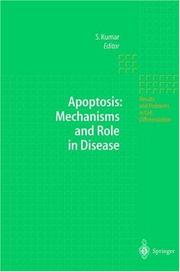| Listing 1 - 7 of 7 |
Sort by
|
Multi
ISBN: 9780128157633 0128157631 0128157623 9780128157626 Year: 2021 Publisher: London : Academic Press,
Abstract | Keywords | Export | Availability | Bookmark
 Loading...
Loading...Choose an application
- Reference Manager
- EndNote
- RefWorks (Direct export to RefWorks)

ISBN: 0199637857 0199637849 9780199637843 9780199637850 Year: 1999 Volume: 216 Publisher: Oxford Oxford university press
Abstract | Keywords | Export | Availability | Bookmark
 Loading...
Loading...Choose an application
- Reference Manager
- EndNote
- RefWorks (Direct export to RefWorks)
Periodical
Abstract | Keywords | Export | Availability | Bookmark
 Loading...
Loading...Choose an application
- Reference Manager
- EndNote
- RefWorks (Direct export to RefWorks)
Cell death --- Apoptosis --- Homeostasis --- Autophagic vacuoles --- Lysosomes --- Apoptosis. --- Autophagic vacuoles. --- Cell death. --- Homeostasis. --- Lysosomes. --- Autofagie. --- Cell Death. --- Autophagy. --- Autophagy --- Cell Death --- Lysosome --- Death, Cell --- Autophagic Cell Death --- Autophagic Programmed Cell Death --- Autophagy, Cellular --- Macro-autophagy --- Macroautophagy --- Programmed Cell Death, Type II --- Autophagocytosis --- Autophagic Cell Deaths --- Autophagies --- Autophagies, Cellular --- Cell Death, Autophagic --- Cell Deaths, Autophagic --- Cellular Autophagies --- Cellular Autophagy --- Death, Autophagic Cell --- Deaths, Autophagic Cell --- Macro autophagy --- Macro-autophagies --- Macroautophagies --- Cell degeneration --- Cellular Senescence --- Cell organelles --- Biological control systems --- Body fluids --- Physiology --- Cells --- Death (Biology) --- Autoregulation --- Apoptosis, Extrinsic Pathway --- Apoptosis, Intrinsic Pathway --- Programmed Cell Death, Type I --- Apoptoses, Extrinsic Pathway --- Apoptoses, Intrinsic Pathway --- Extrinsic Pathway Apoptoses --- Extrinsic Pathway Apoptosis --- Intrinsic Pathway Apoptoses --- Intrinsic Pathway Apoptosis --- Necrosis --- Clonal Deletion --- Superantigens --- Caspases --- Caspase 1 --- In Situ Nick-End Labeling --- Cellular Apoptosis Susceptibility Protein --- Genes, Transgenic, Suicide --- Life Sciences --- Biology --- ER-Phagy --- Lipophagy --- Nucleophagy --- Reticulophagy --- Ribophagy --- ER Phagy --- Autolysosome --- Autolysosomes --- Autofàgia. --- Mort cel·lular

ISBN: 9781559388184 1559388188 9780080528779 0080528775 Year: 1998 Publisher: [Place of publication not identified] JAI Press
Abstract | Keywords | Export | Availability | Bookmark
 Loading...
Loading...Choose an application
- Reference Manager
- EndNote
- RefWorks (Direct export to RefWorks)
At no time since the introduction of cell pathology by Virchov more than a century ago has the outlook for pathology as an integrated discipline been brighter. It is surely clear that the revolution of molecular biology and biotechnology has wrought profound changes in the various basic medical sciences including pathology. But to say this is hardly enough, particularly since the burgeoning field of molecular pathology has been challenged and altered by a powerful concept, namely, programmed cell death. Called apoptosis, which in Greek means falling off, it is intimately connected with cell removal and regeneration; that is, with tissue homeostasis. Nowhere is this more dramatically illustrated as a physiological process than in the gut, endometrium, and embryo. Similarly, little doubt is left that clusters of apoptotic-induced genes are involved in the control of carcinogenesis. The evidence for this is already compelling; it is plain, for instance, that p53 triggers apoptosis whenever DNA repair is incomplete. The question now is, how quickly can the Genome project shed some light on the genetics underlying apoptosis? It is tolerably clear that there is no such thing as a general model of cell injury, but there are models, as it should be. One thing is already certain: cell stress during septicemia is the quintessential model. Death here requires the failure of at least three organs! We are told that oxidative stress plays a major role in the pathogenesis of the syndrome. This is not surprising. The whole subject of reactive oxygen species (ROS) is thus given much weight. By far, the most important mechanisms underlying membrane lesions, due to ROS, are those involving inactivation of several key enzymes among a host of enzymes, lipid peroxidation, and iron speeding up bydroxyl radical production. The stark fact is that evolutionary pressure has produced a fiasco by not endowing the cell with enough antioxidant power or reducing the ROS pool. In organs with high O2 consumption, mitochondrial leakage of O2 (the superoxide anion) could well be considerable. Thus our main point here is that caloric restriction gives us a way of tackling the problem for the time being. One has only to remember that it improves survival. Whether there has been a "breakthrough" is not yet quite certain, but oxidative stress combined with long-term overactivation of glutamate receptors may enable us to understand several neurodegenerative disorders including Parkinson's disease. This broad topic is touched upon in detail in the Neurobiology module (Volume 14). There is a vast literature relating to injury of heart muscle. Two chapters address this topic. Looking back, are we to conclude that a membrane lesion, which is essentially functional, does not exist? Consider, as an example, the NMR experiments in which a raised Pco2, leads very rapidly to a fall in heart muscle pH. We also venture whether it begs several fundamental questions relating to events that precede the onset of necrobiosis. A telling argument is that an early event could be as simple as the root of the problem in ischemia is not as simple as that of a leaky membrane. But the initiating event would seem to be a redox imbalance vix., changes in cytosolic and mitochondrial NAD+/NADH. We urge the student to go back to Volume 4 (Part II) and read, once more, the chapter on Cellular ATP by Harris. In Part IV, the chapter on the Human Heat Shock Response by Jurivich merits a second reading. Though the present volume is a veritable source of many unanswered questions, it has the distinct simplicity of telling us that molecular pathology, like molecular biology, represents a way of thinking.
Histology. Cytology --- Human histology. Human cytology --- Human medicine --- Pathology, Cellular --- Apoptosis --- Free radicals (Chemistry) --- Heart cells --- Anatomy --- Phenomena and Processes --- Medicine --- Cell Physiological Phenomena --- Cells --- Pathology --- Health Occupations --- Disciplines and Occupations --- Health & Biological Sciences --- Pathophysiology

ISBN: 3540646248 3662216256 3540691855 Year: 1999 Publisher: Berlin Springer
Abstract | Keywords | Export | Availability | Bookmark
 Loading...
Loading...Choose an application
- Reference Manager
- EndNote
- RefWorks (Direct export to RefWorks)
The past few years have seen rapid progress in apoptosis research. This volume deals with many of the recent advances made in uncovering the molecular and cellular basis of apoptosis and elaborates on how this accumulating knowledge is helping us to understand the significance of apoptosis in pathogenesis of diseases arising from inappropriate cell death. Further, mechanistic aspects of cell death and role of apoptosis in disease is covered. The articles published in this volume are written by leading experts in the field and should be a vital resource for researchers in biomedicine and cancer research.
Histology. Cytology --- Apoptosis. --- Pathology, Molecular. --- Cell biology. --- Biochemistry. --- Cancer research. --- Cell Biology. --- Biochemistry, general. --- Cancer Research. --- Cancer research --- Biological chemistry --- Chemical composition of organisms --- Organisms --- Physiological chemistry --- Biology --- Chemistry --- Medical sciences --- Cell biology --- Cellular biology --- Cells --- Composition --- Cell death --- Molecular pathology --- Molecular biology --- Physiology, Pathological
Periodical
ISSN: 14749718 14749726
Abstract | Keywords | Export | Availability | Bookmark
 Loading...
Loading...Choose an application
- Reference Manager
- EndNote
- RefWorks (Direct export to RefWorks)
Cell Aging --- Aging --- Cells --- Cellules --- physiology --- Periodicals. --- Vieillissement --- Périodiques --- physiology. --- Aging. --- Chemistry --- Health Sciences --- Life Sciences --- Biochemistry --- General and Others --- Biology --- Cellular Senescence --- Aging, Biological --- Biological Aging --- Senescence --- Cellular Aging --- Aging, Cell --- Cell Senescence --- Replicative Senescence --- Senescence, Cellular --- Senescence, Replicative --- Aging, Cellular --- Senescence, Cell --- ageing --- longevity --- lifespan --- apoptosis --- gerontology --- ageing --- Organisms --- Cytology --- Mutation Accumulation --- Cell Ageing --- Cellular Ageing --- Senescence-Associated Secretory Phenotype --- Ageing, Cell --- Ageing, Cellular --- Phenotype, Senescence-Associated Secretory --- Secretory Phenotype, Senescence-Associated --- Senescence Associated Secretory Phenotype --- Geriatrics --- gerontologie
Periodical
ISSN: 09509232 14765594 Year: 1987 Publisher: Basingstoke Nature Publishing Group.
Abstract | Keywords | Export | Availability | Bookmark
 Loading...
Loading...Choose an application
- Reference Manager
- EndNote
- RefWorks (Direct export to RefWorks)
Oncogene aims to make substantial advances in our knowledge of processes that contribute to cancer by publishing outstanding research. Oncogene propagates work that challenges standard conjecture and builds on previous studies, in particular those that lead to establishing new paradigms in the etio-pathogenesis, diagnosis, treatment, or prevention of cancers, and in processes that drive metastatic spread, and provide important insights into cancer biology beyond what has been revealed thus far. Areas covered by Oncogene include, but are not limited to, the cellular and molecular biology of cancer including resistance to cancer therapies, and development of better approaches to improving survival. Across cancer biology, we have a broad remit encompassing the life sciences and biomedicine, from the most fundamental and theoretical work, through to translational, applied, and clinical research.
Human genetics --- Molecular biology --- Oncology. Neoplasms --- Oncogenes --- Oncogènes --- Periodicals --- periodicals --- Périodiques --- Oncogenes. --- Oncogene --- Transforming Gene --- Transforming Genes --- Gene, Transforming --- Genes, Transforming --- Health Sciences --- Life Sciences --- Clinical Medicine --- Cytology, Cell Biology --- Genetics --- Oncogènes --- Périodiques --- EBSCOASP-E EJMEDEC EPUB-ALPHA-O EPUB-PER-FT MDGENETI MDNEOPLA NPG-E --- periodicals. --- moleculaire biologie --- MDGENETI MDNEOPLA --- Onc genes --- Cancer genes --- Proto-oncogenes --- Medicine --- Internal medicine --- Oncology --- Cell biology --- Apoptosis --- Medicine/Public Health, general --- Internal Medicine --- Cell Biology --- Human Genetics --- Heredity, Human --- Human biology --- Physical anthropology --- Cell death --- Cellular biology --- Biology --- Cells --- Cytologists --- Tumors --- Medicine, Internal --- Health Workforce --- Journal --- Tumors.
| Listing 1 - 7 of 7 |
Sort by
|

 Search
Search Feedback
Feedback About UniCat
About UniCat  Help
Help News
News